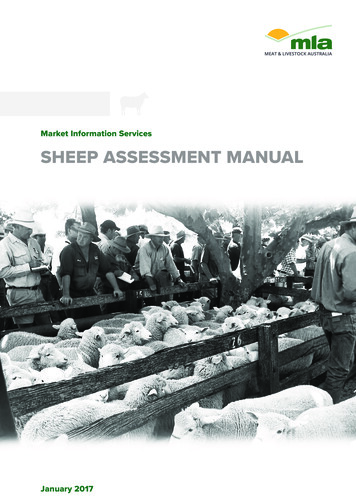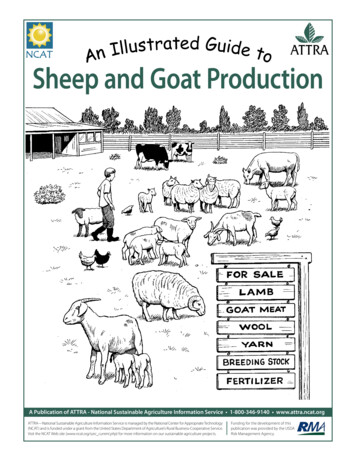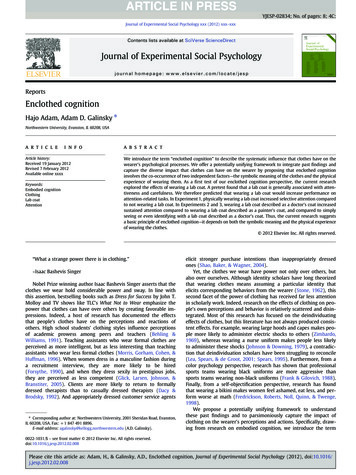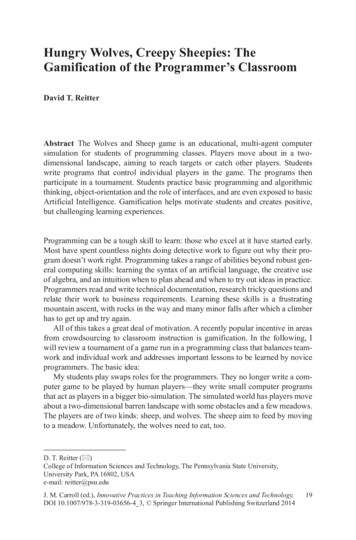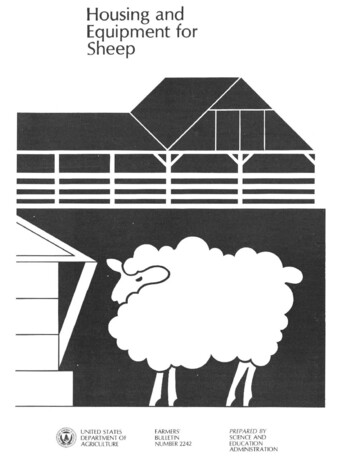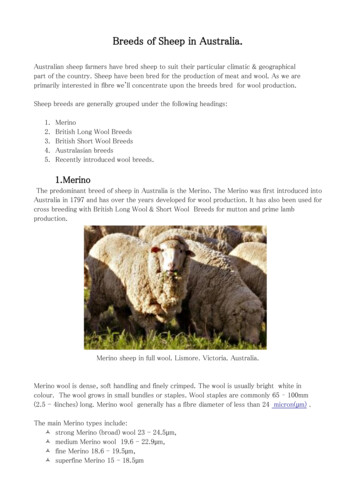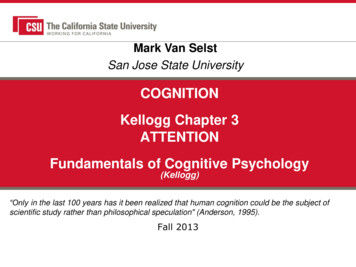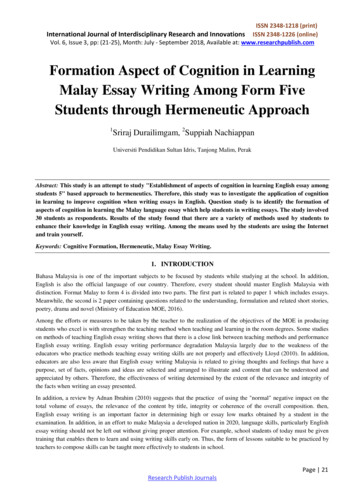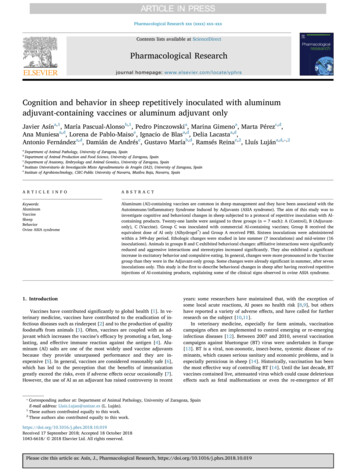
Transcription
Pharmacological Research xxx (xxxx) xxx–xxxContents lists available at ScienceDirectPharmacological Researchjournal homepage: www.elsevier.com/locate/yphrsCognition and behavior in sheep repetitively inoculated with aluminumadjuvant-containing vaccines or aluminum adjuvant onlyJavier Asína,1, María Pascual-Alonsob,1, Pedro Pinczowskia, Marina Gimenoa, Marta Pérezc,d,Ana Muniesaa,d, Lorena de Pablo-Maisoe, Ignacio de Blasa,d, Delia Lacastaa,d,⁎Antonio Fernándeza,d, Damián de Andrése, Gustavo Maríab,d, Ramsés Reinae,2, Lluís Lujána,d, ,2aDepartment of Animal Pathology, University of Zaragoza, SpainDepartment of Animal Production and Food Science, University of Zaragoza, SpaincDepartment of Anatomy, Embryology and Animal Genetics, University of Zaragoza, SpaindInstituto Universitario de Investigación Mixto Agroalimentario de Aragón (IA2), University of Zaragoza, SpaineInstitute of Agrobiotechnology, CSIC-Public University of Navarra, Mutilva Baja, Navarra, SpainbA R T I C LE I N FOA B S T R A C TKeywords:AluminumVaccineSheepBehaviorOvine ASIA syndromeAluminum (Al)-containing vaccines are common in sheep management and they have been associated with theAutoimmune/inflammatory Syndrome Induced by Adjuvants (ASIA syndrome). The aim of this study was toinvestigate cognitive and behavioral changes in sheep subjected to a protocol of repetitive inoculation with Alcontaining products. Twenty-one lambs were assigned to three groups (n 7 each): A (Control), B (Adjuvantonly), C (Vaccine). Group C was inoculated with commercial Al-containing vaccines; Group B received theequivalent dose of Al only (Alhydrogel ) and Group A received PBS. Sixteen inoculations were administeredwithin a 349-day period. Ethologic changes were studied in late summer (7 inoculations) and mid-winter (16inoculations). Animals in groups B and C exhibited behavioral changes: affiliative interactions were significantlyreduced and aggressive interactions and stereotypies increased significantly. They also exhibited a significantincrease in excitatory behavior and compulsive eating. In general, changes were more pronounced in the Vaccinegroup than they were in the Adjuvant-only group. Some changes were already significant in summer, after seveninoculations only. This study is the first to describe behavioral changes in sheep after having received repetitiveinjections of Al-containing products, explaining some of the clinical signs observed in ovine ASIA syndrome.1. IntroductionVaccines have contributed significantly to global health [1]. In veterinary medicine, vaccines have contributed to the eradication of infectious diseases such as rinderpest [2] and to the production of qualityfoodstuffs from animals [3]. Often, vaccines are coupled with an adjuvant which increases the vaccine’s efficacy by promoting a fast, longlasting, and effective immune reaction against the antigen [4]. Aluminum (Al) salts are one of the most widely used vaccine adjuvantsbecause they provide unsurpassed performance and they are inexpensive [5]. In general, vaccines are considered reasonably safe [6],which has led to the perception that the benefits of immunizationgreatly exceed the risks, even if adverse effects occur occasionally [7].However, the use of Al as an adjuvant has raised controversy in recentyears: some researchers have maintained that, with the exception ofsome local acute reactions, Al poses no health risk [8,9], but othershave reported a variety of adverse effects, and have called for furtherresearch on the subject [10,11].In veterinary medicine, especially for farm animals, vaccinationcampaigns often are implemented to control emerging or re-emerginginfectious diseases [12]. Between 2007 and 2010, several vaccinationcampaigns against bluetongue (BT) virus were undertaken in Europe[13]. BT is a viral, non-zoonotic, insect-borne, systemic disease of ruminants, which causes serious sanitary and economic problems, and isespecially pernicious in sheep [14]. Historically, vaccination has beenthe most effective way of controlling BT [14]. Until the last decade, BTvaccines contained live, attenuated virus which could cause deleteriouseffects such as fetal malformations or even the re-emergence of BT⁎Corresponding author at: Department of Animal Pathology, University of Zaragoza, SpainE-mail address: Lluis.Lujan@unizar.es (L. Luján).1These authors contributed equally to this work.2These authors also contributed equally to this eived 17 September 2018; Accepted 18 October 20181043-6618/ 2018 Elsevier Ltd. All rights reserved.Please cite this article as: Asín, J., Pharmacological Research, https://doi.org/10.1016/j.phrs.2018.10.019
Pharmacological Research xxx (xxxx) xxx–xxxJ. Asín et al.Table 1Commercial vaccines used in the experiment to inoculate lambs in Group C.Aluminum content was measured by inductively coupled plasma atomic emissionspectrometry and is expressed as per dose.VaccineCommercial nameManufacturerAntigen/sdpi*mg of Al#/dose12Heptavac P PlusAutogenousvaccineVanguard RAgalaxipraOvivac CSAutogenousvaccineBluevac-1Bluevac-4MSD Animal Health S.L.ExopolPasteurella multocida, Mannheimia haemolytica, Clostridium spp.Staphylococcus aureus spp. anaerobius0, 23, 23344, 697.51.644ZoetisHipraHipraExopolRabies virusMycoplasma agalactiaeChlamydophila abortus, Salmonella abortus ovisCorynebacterium pseudotuberculosis98129, 146209, 233254, 2721.0256.7645.61.32CZ Veterinaria S.A.CZ Veterinaria S.A.Bluetonge virus serotype 1Bluetongue virus serotype 4293, 329293, 3294.184.16345678*: dpi: days post first inoculation.#: Al: Aluminum.experimental research farm of the University of Zaragoza. Twenty-oneunvaccinated, neutered, male purebred Rasa Aragonesa lambs wereselected at 3 months of age from a pedigree flock of certified goodhealth and assigned to one of three groups of seven animals each. GroupA (Control) was inoculated with PBS, Group B (Adjuvant-only) wasinoculated with the adjuvant only, and Group C (Vaccine) was inoculated with commercial vaccines that contained Al as adjuvant. Theexperiment ran from Feb 2015 to Feb 2016 (349 days), which includeda full summer and a winter period.[15,16]. Since 2007, vaccines used in Europe have contained inactivated virus and Al hydroxide as an adjuvant [17,18]. By 2008, inSpain, several serotypes were circulating concurrently and, typically,two serotypes predominated in a given geographical area [19]. In response, throughout the country, a dual vaccination program was implemented that included two vaccines against the two serotypes circulating in each area. Animals received four vaccine doses within abouta month, which culminated in an inoculation of 16 mg of Al per animal.After those vaccinations, a previously unreported syndrome was identified [20,21], which was characterized by an acute phase that includedsevere neurological symptoms with lesions of sterile meningoencephalitis, and a chronic phase that involved extreme weight loss and neurodegenerative lesions in the spinal cord. The chronic phase correlatedwith low environmental temperatures. All known ovine diseases wereruled out as a cause of the syndrome, and it was concluded that theprocess was associated with the use of Al-adjuvant containing vaccines,and has been included under the umbrella of the Autoimmune/inflammatory Syndrome Induced by Adjuvants (ASIA syndrome) [21,22].In the chronic phase, sheep exhibited a variety of behavioral changesincluding periods of depression (i. e., lack of response to stimuli, stupor)and lethargy intermixed with periods of excitement, restlessness,polyphagia, and increased aggressiveness, especially compulsive woolbiting between animals. Some of those behavioral changes were reproduced in a small cohort of repeatedly vaccinated lambs, but theywere not fully characterized [21]. Similar behavioral changes havebeen observed in experimental laboratory animals that were inoculatedwith Al adjuvants [23].Several validated tests have been used to assess behavioral andcognitive changes in sheep. Home pen observations have been used toquantify social and individual behaviors [24–27], whereas T-maze test,Open Field Test (OFT), and Novel Object Test (NOT) have been used toevaluate specific aspects of cognition. The T-maze test has been validated as a means of studying various aspects of spatial learning andworking memory in sheep [28–31], OFT has been used to assess theresponse of an animal to a novel environment and isolation from theflock mates [28,32,33], and NOT has been applied to quantify the fearreactions of sheep [34,35]. The aim of this study was to investigate thebehavioral and cognitive changes in sheep repeatedly inoculated withAl adjuvant-containing vaccines or Al adjuvant only.2.2. Management of the animalsHousing and management conditions and diet were identical for allanimals. The three groups were isolated from each other, but they occupied contiguous, identical pens within the same building. Pens wererectangular closed rooms, 7 3.5 x 6 m (length x width x height), opento the exterior of the building at one of the short walls through fourclosable windows. The daily ration was 1 kg of concentrate per animal,and straw and water ad libitum. Concentrate (Agroveco , Zaragoza,Spain) contained 15.7% crude protein, 3.9% crude fat, 10.4% crudefiber, 9.5% crude ash, 0.22% sodium, and adequate proportions ofmineral and vitamin supplements for growing lambs. Each day at0830 h, concentrate was offered from a 2-m-long hopper that had twoopenings, which permitted all animals in a group to eat simultaneously.Minimum, maximum, and average ambient daily temperatures in thearea were obtained from the Spanish Agency of Meteorology (AEMET).The average daily temperature was 25.5 C in summer and 9.0 C inwinter.2.3. Vaccination protocolLambs underwent an accelerated vaccination schedule, designed toinoculate -within an acceptable experimental time frame- an Al loadequivalent to that a sheep under local management field conditionsusually receives along 6–7 years. Animals in Group C (Vaccine) wereinoculated with commercial vaccines against main ovine diseases(Table 1, Fig. 1), receiving 16 vaccine doses within 12 months and atotal of 70.861 mg of Al. The recommended application procedures foreach product were always followed. Animals in Group B (Adjuvantonly) were inoculated with Al-hydroxide only (Alhydrogel , CZ Veterinaria, Spain), at concentrations that were identical to those of thecorresponding commercial vaccine, measured by inductively coupledplasma atomic emission spectrometry (Table 1). Group A was inoculated with an identical volume of PBS. All inoculations were performed in the subcutaneous tissue of the area encompassing scapulaand ribs, using individual, sterile disposable syringe and needle for eachinjection.2. Materials and methods2.1. Experimental designAll experimental procedures were approved and licensed by theEthical Committee of the University of Zaragoza (ref: PI15/14).Requirements of the Spanish Policy for Animal Protection (RD53/2013)and the European Union Directive 2010/63 on protection of experimental animals were always fulfilled. The study was carried out at the2
Pharmacological Research xxx (xxxx) xxx–xxxJ. Asín et al.Fig. 1. Vaccination schedule. Each bar represents an inoculation date. In total, 16 inoculations were administered on one of 13 days. dpi: days post first inoculation.of events in which an animal displayed a specific behavior. Individualbehaviors included feeding on concentrate, eating straw, resting,standing, and drinking. Social behaviors were assigned to one of threecategories: i) affiliative interactions, ii) agonistic (aggressive) interactions and iii) stereotypies. Alternative text: A description of the individual and social behaviors evaluated is detailed in SupplementaryTables S2 and S3.2.4. Cognitive and behavioral assessmentsAnimals were subjected to two rounds of each of the tests describedbelow. The first round began at 196 days post first inoculation (dpi), inSeptember 2015 (late summer). The second round began at 336 dpi, inJanuary 2016 (mid-winter; Supplementary table S1). In the summerround, all animals had been inoculated 7 times and, in the winterround, the animals had been inoculated 16 times.2.5. Hematology panel and welfare indicators2.4.1. Cognitive test: T-mazeEach animal was subjected to the T-maze test on two consecutivedays in summer and in winter rounds. The order in which lambs weretested alternated among the three groups, and the order was maintained in all tests. Tests were performed in a T-maze built of 1.4-m-highplastic panels, which had been validated for use with lambs [28]. Amirror clue and a loudspeaker were placed at floor level in the targetzone in the left arm of the maze, which served as a social and a soundclue, respectively. Each animal was given up to 5 min to solve the maze.Video recordings of each test were blindly evaluated by a trained researcher (MPA) and latency, time taken to reach the target zone, timespent solving the maze, and the number of areas traversed was obtained.A standardized hematology panel was performed, and welfare andstress indicators including cortisol, creatine kinase (CK), lactate, glucose, non-esterified fatty acids (NEFA) and neutrophil/lymphocyte (N/L) ratio [36,24,37–39] were measured on the day after the recordingperiod in each of the two rounds, away from recent handling of theanimals (Supplementary Table S1). Blood samples were taken at 0800 hby jugular venipuncture, which required 1 min per lamb. The leukocyte formula was estimated from blood Diff-Quick stained smears.The N/L ratio was calculated based on 100 leukocytes per sample.Cortisol concentration (nmol/L) in plasma was measured by enzymeimmunoassay [40].2.6. Statistical analysis2.4.2. Cognitive test: Open Field Test (OFT) and Novel Object Test (NOT)Each animal was subjected to the OFT once in each of the tworounds. The order in which lambs were tested alternated among thethree groups, and the order was maintained in all tests. The 4 x 4 m testarena built with 1.40 m high plastic panels, served as a novel environment for the animal that was completely isolated from otherlambs. Water and food were offered from a bucket. Each animal was leftin the test arena for 5 min, which was recorded with a videotape and amicrophone. From the recordings, the observer (MPA) blindly calculated time the animal spent walking, exploring, standing, and trying toescape, among others parameters.The NOT was performed in the same test arena. A blue plastic ballwas lowered twice from the ceiling at the center of the arena and leftthere for 1 min. The observer recorded the distance between the lamband the ball after 30 s, each time.Comparisons were performed as follows: T-maze test: Unpairedcomparisons between groups for each of the two days of the test in eachround, and paired comparisons within groups between the two days ofthe test in each round. OFT: Unpaired comparisons between groupswithin each round of tests and paired comparisons within groups between the two rounds. NOT: Unpaired comparisons between groups foreach of the two distances to the novel object in each of the rounds, and,within each group, paired comparisons between the two distances ineach round. Behavior: Unpaired comparisons between groups withineach round of tests and paired comparisons within groups between thetwo rounds, which were restricted to social behaviors because of seasonal influences on individual behaviors due to normal physiologicalseasonal variations (e.g., all groups drank more water in summer andate more straw in winter). For most of the parameters in the hematology panel and the welfare indicators, unpaired comparisons betweengroups were performed for each round, and within-group paired comparisons between rounds were performed for cortisol, only.A Shapiro-Wilk s Test was used to confirm whether the data of thequantitative variables met the assumption of normality. A parametrictest was used if the variable met the assumption, and a non-parametrictest was used if it did not. Unpaired comparisons were performed usingan ANOVA (A) Test (or Welch’s t-test (We) if variances were nothomogeneous based on a Levene’s test) and a post hoc Duncan’s test(parametric tests), or a Kruskal-Wallis (KW) test and a post hoc Dunn’stest (non-parametric test). Paired comparisons were performed usingStudent’s t (t) test for dependent samples (parametric test) or aWilcoxon (W) test (non-parametric test). General lineal models (GLM)were developed to assess the influence of “Group” and “Round”, andtheir paired interactions on the behavioral tests. All statistical analyseswere performed using IBM SPSS 19.0 for Windows (IBM Corp., Armonk,NY, USA). The alpha and beta levels were set at 0.050 and 0.200, respectively.2.4.3. Behavioral tests: home pen individual and social behaviorobservationsAll lambs were individually identified by numbers painted on theirsides and rump. To record social and individual behaviors, a camerawas placed at the top of each pen, and a videorecorder (Circontrol S.A.,Spain) was set up in a room adjacent to the pens. In each of the tworounds, recordings were made for 12 h/day (0800 h – 2000 h) on sevenconsecutive days. After the experiment had concluded, a trained researcher (MPA) analyzed the videos consecutively in a blind manner.The video data were quantified in two ways: Instantaneous sampling for individual behaviors, and continuous sampling for social behaviors. Instantaneous sampling involved quantifying 1 min from each10 min of video, totaled 504 min per group and 1512 min per round.Continuous sampling involved quantifying three 2-h periods per day(0800 h – 1000 h, 1200 h – 1400 h and 1600 h – 1800 h) which totaled42 h of observations per group and 126 h per round. The analysis ofboth individual and social behaviors involved documenting the number3
Pharmacological Research xxx (xxxx) xxx–xxxJ. Asín et al.3.2.2. Social behaviorIn summer, the level of affiliative interactions did not differ amonggroups (Fig. 4, Supplementary Table S26) but lambs in groups B and Cexhibited significantly (pKW 0.001) more aggressive interactions(Fig. 5, Supplementary Table S27) and stereotypies (Fig. 6, Supplementary Table S28) than did lambs in Group A, and Group C lambsexhibited significantly (pKW 0.001) more stereotypies than did GroupB lambs. In winter, Group C lambs exhibited significantly(pKW 0.001) fewer affiliations than did Group B lambs (Fig. 4, Supplementary Table S26). Furthermore, in winter, lambs in groups B andC showed significantly (pKW 0.001) fewer affiliations (Fig. 4, Supplementary Table S26), more aggressive interactions (Fig. 5, Supplementary Table S27) and stereotypies (Fig. 6, Supplementary Table S28)than did lambs in Group A.In groups B and C, the frequency of affiliations was significantlylower (Group B: pW 0.045; Group C: pW 0.001; Fig. 4, Supplementary Table S26) and the frequency of aggressive interactions wassignificantly higher (Group B: pW 0.018; Group C: pW 0.003; Fig. 5,Supplementary Table S27) in winter than it was in summer. In Group C(pW 0.002) lambs exhibited significantly more stereotypies in winterthan they did in summer (Fig. 6, Supplementary Table S28). In Group A,those three types of behaviors did not differ significantly betweensummer and winter (Figs. 4–6). The GLM indicated that the interactioneffect between “Group” and “Round” was significant for affiliative interactions (p 0.002) and aggressive interactions (p 0.024) (Supplementary Table S29). By the end of the winter round (February2016), animals in Group C exhibited wool biting, and five of sevenlambs had multifocal areas of wool loss and depilation, normally in therumps and withers (Supplementary Fig S1).Fig. 2. Open Field Test (OFT). Trying to escape. Lambs in Group C (Vaccine,red) spent less time trying to escape the test arena in the winter round of tests(*pt 0.003). Statistical analysis was performed using Student’s t-test for dependent samples. Central bars indicate the median. The extremes of the boxesrepresent the first (Q1, lower) and third (Q3, upper) quartiles. Boxes representthe interquartile range (IQ Q3-Q1), which indicates 50% of the data. Whiskerbars were calculated from the IQ (Upper: Q3 1.5 x IQ; lower: Q1 – 1.5 x IQ),and reflect the variability of the data outside Q1 and Q3. Data are presented inSupplementary Table S14.3.3. Hematology panel and welfare indicators3. ResultsIn summer, the hematology panels of the three groups did not differsignificantly. In winter, the white blood cells (WBC; pA 0.047) andeosinophil number (pKW 0.016) were higher in Group C than theywere in the other two groups. In summer, cortisol levels did not differsignificantly between groups, however, in winter, cortisol levels weresignificantly higher in groups B and C than they were in Group A(pA 0.005). Furthermore, in Group A, but not in groups B and C,cortisol levels were significantly (pt 0.002) lower in winter than theywere in summer (Fig. 7) (Supplementary Tables S30 - S31).3.1. Cognitive tests3.1.1. T-maze testThere were no significant differences between groups in any of thetwo rounds (summer or winter). Within groups, there were no significant differences between the two consecutive days of testing insummer. In winter, however, Group C left the first area (latency) significantly (pW 0.027) earlier on the second day of testing(Supplementary Tables S4 – S11).4. Discussion3.1.2. OFT and NOTIn neither summer nor winter did the three groups differ significantly between them in either of the two tests. In the OFT in winter,Group B lambs spent significantly (pW 0.043) more time exploringthan they did in summer and Group C lambs spent significantly(pt 0.003) less time trying to escape (Fig. 2). In the NOT, in winter,Group B lambs were significantly (pW 0.043) farther from the novelobject in the second exposure than they were in the first exposure(Supplementary Tables S12 – S19).This is the first scientific study to investigate cognitive and behavioral changes in sheep after inoculation with Al-containing products.Following compulsory vaccination campaigns against BT in the lastdecade, several behavioral changes were observed [20,21], whichprompted research into the putative relationship between subcutaneously injected Al-containing vaccines and those changes. Here,we have used an experimental model to demonstrate that sheep repetitively inoculated with vaccines containing Al hydroxide or with Alhydroxide only exhibit behavioral changes similar to those reportedpreviously for the ovine ASIA syndrome.This experiment tries to reproduce in a short period of time, theclinical effects of successive inoculation of vaccines. Several vaccinations are administered annually to most flocks as preventative measuresagainst a variety of infectious diseases, which sometimes involves theconcurrent use of more than one vaccine [41]. Furthermore, mostvaccinations are administered to sheep of all ages, e. g., an individualreceives vaccine doses throughout its productive life. Sheep might receive additional vaccines if, for instance, there is an outbreak of amandatory reportable infectious disease such as the BT outbreak inEurope [19]. In some flocks, sheep can receive a mean of 2–4 vaccinesper year and a range of 14–28 vaccines in a 7 years life-span. Mostsheep vaccines contain about 2 mg Al/ml, the normal dose is 2 ml, and3.2. Behavioral tests3.2.1. Individual behaviorIn summer, Group C ate straw significantly (pKW 0.018) less frequently than did Group A lambs. Lambs in groups C and B spent significantly (pA 0.001) more time standing than did lambs in Group A.In winter, Group C and Group B lambs ate concentrate significantly(pKW 0.001) fewer times than did Group A lambs. Lambs in Group Brested less often (pKW 0.027) than did lambs in Group A and lambs inGroup C and Group B stood significantly more often (pA 0.001) thandid lambs in Group A (Fig. 3). The GLM indicated that the interactioneffect between “Group” and “Round” was significant (p 0.035) forstanding (Supplementary Tables S20 - S25).4
Pharmacological Research xxx (xxxx) xxx–xxxJ. Asín et al.Fig. 3. Individual behavior: Resting (a) and standing (b) in the winter round of tests.Group B (Adjuvant-only, yellow) lambs spent less time resting (*pKW 0.027) than Group A (Control, green) lambs. Group B (Adjuvant-only, yellow) lambs andGroup C (Vaccine, red) lambs spent more time standing (**pA 0.001) than Group A (Control, green) lambs. Statistical comparisons were based on Kruskal-Wallis(KW) and post hoc Dunn’s test for resting, and an ANOVA (A) test and post hoc Duncan’s test for standing. Central bars indicate the median. The extremes of the boxesrepresent the first (Q1, lower) and third (Q3, upper) quartiles. Boxes represent the interquartile range (IQ Q3-Q1), which indicates 50% of the data. Whisker barswere calculated from the IQ (Upper: Q3 1.5 x IQ; lower: Q1 – 1.5 x IQ), and reflect the variability of the data outside Q1 and Q3. Data are presented inSupplementary Tables S22-S23.Fig. 4. Social behavior: Affiliative interactions. Group B (Adjuvant-only,yellow) performs less affiliative interactions in winter (*pW 0.045). Group C(Vaccine, red) performs less affiliative interactions in winter (**pW 0.001).Groups B (Adjuvant-only, yellow) and C (Vaccine, red) perform less affiliativeinteractions than Group A (Control, green) in the winter round (#pKW 0.001).In addition, in the winter round, Group C (Vaccine) performs less affiliativeinteractions than Group B (Adjuvant-only, yellow) (#pKW 0.001).Comparisons within groups were performed by Wilcoxon (W) test. Comparisonsbetween groups were performed by Kruskal-Wallis (KW) test and post hocDunn’s test. Central bars indicate the median. The extremes of the boxes represent the first (Q1, lower) and third (Q3, upper) quartiles. Boxes represent theinterquartile range (IQ Q3-Q1), which indicates 50% of the data. Whiskerbars were calculated from the IQ (Upper: Q3 1.5 x IQ; lower: Q1 – 1.5 x IQ),and reflect the variability of the data outside Q1 and Q3. Data are shown inSupplementary Table S26.Fig. 5. Social behavior: Agonistic (aggressive) interactions. Group B (Adjuvantonly, yellow) performs more aggressive interactions in winter (*pW 0.018).Group C (Vaccine, red) performs more aggressive interactions in winter(**pW 0.003). Groups B (Adjuvant-only, yellow) and C (Vaccine, red) perform more aggressive interactions when comparing with Group A (control,green) both in the summer (#pKW 0.001) and in the winter (##pKW 0.001)rounds. Comparisons within groups were performed by Wilcoxon (W) test.Comparisons between groups were performed by Kruskal-Wallis (KW) test andpost hoc Dunn s test. Central bars indicate the median. The extremes of theboxes represent the first (Q1, lower) and third (Q3, upper) quartiles. Boxesrepresent the interquartile range (IQ Q3-Q1), which indicates 50% of thedata. Whisker bars were calculated from the IQ (Upper: Q3 1.5 x IQ; lower:Q1 – 1.5 x IQ), and reflect the variability of the data outside Q1 and Q3. Dataare shown in Supplementary Table S27.5
Pharmacological Research xxx (xxxx) xxx–xxxJ. Asín et al.Fig. 6. Social behavior: Stereotypies. Group C (Vaccine, red) performed morestereotypies in the winter round (*pW 0.002). Groups B (Adjuvant-only,yellow) and C (Vaccine, red) performed more stereotypies than did Group A(Control, green) in the summer (#pKW 0.001) and the winter(##pKW 0.001) rounds. Furthermore, Group C (Vaccine, red) performed morestereotypies than did Group B in the summer round (#pKW 0.001).Comparisons within groups were performed by Wilcoxon (W) test. Comparisonsbetween groups were performed by Kruskal-Wallis (KW) test and post hocDunn’s test. Central bars indicate the median. The extremes of the boxes represent the first (Q1, lower) and third (Q3, upper) quartiles. Boxes represent theinterquartile range (IQ Q3-Q1), which indicates 50% of the data. Whiskerbars were calculated from the IQ (Upper: Q3 1.5 x IQ; lower: Q1 – 1.5 x IQ),and reflect the variability of the data outside Q1 and Q3. Data are shown inSupplementary Table S28.Fig. 7. Plasma cortisol levels. Group A (Control, green) shows a decrease in thecortisol levels (*pt 0.002) when comparing the winter and the summerround. Groups B (Adjuvant, yellow) and C (Vaccine, red) show higher cortisollevels than Group A (control, green) in the winter round (#pA 0.005).Comparisons within groups were performed by Student’s t-test (t). Comparisonsbetween groups were performed by ANOVA (A) test and post hoc Duncan’s test.Central bars indicate the median. The extremes of the boxes represent the first(Q1, lower) and third (Q3, upper) quartiles. Boxes represent the interquartilerange (IQ Q3-Q1), which indicates 50% of the data. Whisker bars were calculated from the IQ (Upper: Q3 1.5 x IQ; lower: Q1 – 1.5 x IQ), and reflect thevariability of the data outside Q1 and Q3. Data are shown in SupplementaryTables S30 and S31.OFT in winter, which might reflect a reduction in social tendencies inthe vaccinated lambs because, in this test, the animal tries to escape theisolation of the arena and return to the group [46]. In addition, Vaccineanimals left the first area of the T-maze test (latency) earlier in thesecond day than they did on the first day of the winter round, althoughthe time taken to solve the maze did not differ. The significant difference in latency between days might have been a product of the exceptionally long latency of the animals in the Vaccine Group on the firstday of the test. In winter, lambs in the Adjuvant-only Group spent moretime exploring (OFT) than they did in summer and they kept fartheraway from the novel object in the second exposure (NOT). Thosechanges might reflect a level of agitation or fear [47,33]. Collectively,the cognitive tests presented to the lambs indicated some changes in theVaccine and Adjuvant-only groups, how
round, all animals had been inoculated 7 times and, in the winter round, the animals had been inoculated 16 times. 2.4.1. Cognitive test: T-maze Each animal was subjected to the T-maze test on two consecutive days in summer and in winter rounds. The order in which lambs were tested alternated among the three groups, and the order was main-
